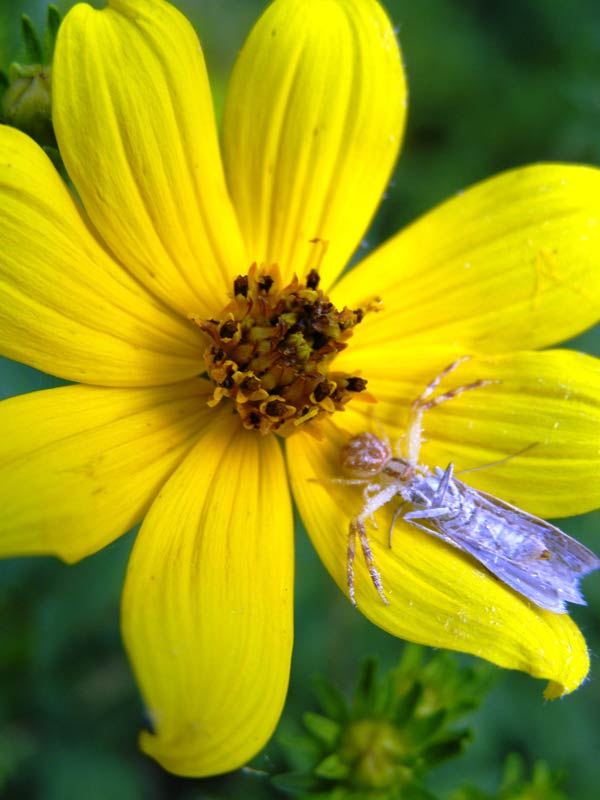A tale of two plants

Closeup of Bidens flower head showing central tiny disc flowers surrounded by ray flowers hosting a crab spider with captured prey. Photo by Ken Moore
By Ken Moore
Flora Columnist
One plant
To me, Labor Day means the flowering of Bidens aristosa and Bidens polylepis. Don’t worry about which is which. Their golden-yellow, daisy-like flowers are so similar that I leave it to the younger botanists to devote long hours to sorting them. It’s enough for me to know that the former occurs in the coastal plain and the later occurs in the mountains and both commonly overlap in our piedmont.
The Latin name, Bidens, means two teeth; it’s descriptive of two tooth-like projections on top of the flattened seed of some species. You will recognize and cuss the seed of the very common Spanish Needles, Bidens bipinnata, with three and four long needle-like teeth that grab your clothes by the hundreds during fall walks. Spanish Needles don’t have showy flowers like the first two species mentioned above. The showy-flowered Bidens go by numerous common names: Bur Marigold, Tickseed, Ditch Daisy, Ozark Tickseed Sunflower, and the list goes on. You take your pick. Go ahead, make up your own name and you’re more likely to remember it.
Look for Bidens making spectacular displays along roadsides and, once in a while, filling an entire abandoned or fallow field. You most likely won’t see the same Bidens-filled field more than one year, because this brilliant fall flower is one of our state’s few true annuals – i.e., it sprouts, flowers, sets seed and dies in one season. The annuals are replaced by longer-lived perennials like asters, goldenrods and native grasses that remain in that field until they, in turn, are displaced by naturally invading shrubs and trees. Watching “old-field succession†is a yearly adventure of floral and faunal discoveries.
Like so many fall wildflowers – including asters, goldenrods and wild sunflowers, of which there are dozens of species – Bidens is a member of the Aster or Composite family. Take a close look and you will observe a “head†of dozens, sometimes hundreds, of tiny tubular (disc) flowers surrounded by a circle of more obvious ray flowers. A single Bidens plant can reach a height of six feet and sport several hundred separate flower heads. Some other composites, like dandelion and chicory, have all ray flowers and some, like Joe-Pye Weed, have all disc flowers.
Now if this doesn’t excite you, then take a closer look for a whole world of insects, from butterflies, flies, fireflies, bees and spiders (which are not true insects) on each Bidens head. You won’t examine many flower heads before discovering some unfortunate insect in the jaws of a spider, probably one of the crab spiders that changes color to match the flower and lies in wait for the unsuspecting victim.
In my wild garden, I make certain that I have some bare ground for Bidens to return every year. I even have some in pots to bring up on the deck when in flower. I enjoy watching those tricky spiders!
The other plant
Also growing along my driveway is ragweed, Ambrosia artemisiifolia, another annual that intermingles with Bidens, as it often does with the showy goldenrods (see The Carrboro Citizen, August 23). The cut-leaf foliage is very similar on both plants. But take note: ragweed lacks the showy, colorful flowers of other composites. The female flowers of ragweed are hard-to-spot little nutlets forming in the leaf axils; the male flowers are vertical columns of pollen-bearing structures, the real culprit for hay fever sufferers. The showy flowers get the bad rap. Now you know better. Ragweed’s Latin name, ambrosia, is very inappropriate; it is definitely not a “nectar of the Gods.â€
Email Ken Moore at flora@carrborocitizen.com.
Find all of Ken Moore’s Citizen columns at The Annotated Flora
.

Compare the spiked male pollen-bearing flowers of hay fever culprit Ragweed with the larger showy flowers of innocent Bidens. Photo by Ken Moore


Comments are closed.